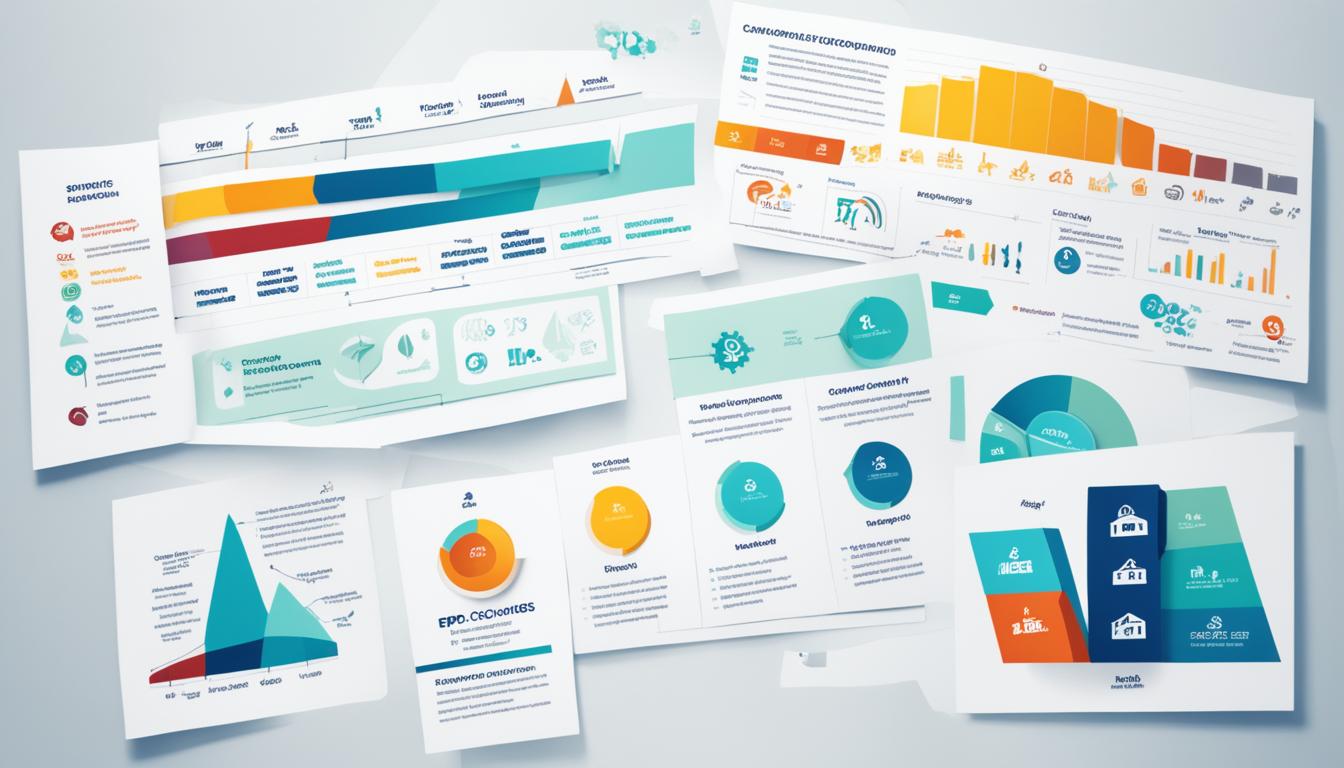The macro environment greatly affects a business’s marketing strategy. It includes outside conditions and factors that play a role in how a business works and connects with its audience. By looking at the macro environment, companies can spot future chances, face challenges, and keep up with trends affecting their marketing.
Factors outside marketing, like the economy, politics, society, technology, rules, and the environment, all matter. These elements strongly affect businesses no matter the industry. That’s why it’s key to check and think about these when making marketing plans.
Key Takeaways:
- The macro environment in marketing refers to the external conditions and factors that influence a business’s marketing strategies.
- An understanding of the macro environment is crucial for businesses to identify opportunities and anticipate challenges.
- Factors such as the economy, politics, society, technology, legal regulations, and the environment contribute to the macro environment.
- Analyzing the macro environment involves conducting a PESTLE analysis to consider various factors.
- The impact of the macro environment varies across industries and can shape business strategies and innovation.
What is the Macro Environment?
The macro environment includes all the broad forces affecting the economy. It goes beyond specific sectors or regions. These forces deeply influence companies and how they market themselves. Knowing about this environment helps firms to stay ahead and make smart choices.
The economy is a big piece of the macro environment. Things like GDP, inflation, and how much people are buying and working matter a lot. They signal what might happen next in the economy. Businesses use this info to plan their marketing.
Moreover, the macro environment has many aspects that touch businesses in every field. Political issues, like laws and rules, matter. So do social trends and tech changes. Environmental issues play a big role too.
Companies must understand the macro environment well. It lets them spot chances and see possible problems. By keeping an eye on this big picture, businesses can shape their marketing to win in the market.
Key Elements of the Macro Environment:
- Economy: GDP, inflation, employment rates, consumer spending
- Political factors: Government policies, regulations, trade agreements
- Social factors: Cultural norms, demographic trends, consumer behavior
- Technological factors: Technological advancements, digital disruption
- Environmental factors: Sustainability, climate change, green initiatives
Impact on Individual Business Sectors
Different sectors get hit by the macro environment in their own ways. Some feel the pinch of economics more, while others wrestle with political or tech changes. Here’s how various industries are influenced:
| Industry | Impact of Macro Environment |
|---|---|
| Tech Industry | Driven by technological advancements, disruptive innovations, and changing consumer preferences. |
| Retail Industry | Subject to changes in consumer spending patterns, evolving shopping habits, and economic conditions. |
| Healthcare Industry | Regulated by policies, technological advancements in healthcare practices, and shifting demographics. |
| Food Industry | Affected by environmental concerns, changing consumer preferences, and health and wellness trends. |
| Automotive Industry | Influenced by technological advancements, environmental regulations, and consumer demand for sustainable solutions. |
| Tourism Industry | Impacted by political factors, safety concerns, environmental conditions, and travel restrictions. |
| Education Industry | Shaped by technological innovations, changes in educational policies, and evolving societal attitudes towards education. |
Knowing the macro environment’s specific effects helps businesses. They can adjust their strategies to use chances well and lessen risks.
Key Factors of the Macro Environment
Analyzing the macro environment is key for strategic management in businesses. A PESTLE analysis is performed to understand various external factors. These include politics, economics, socio-cultural influences, technology, legal rules, and the environment. Knowing these helps businesses understand outside forces and make better decisions.
The Gross Domestic Product (GDP) is crucial to the macro environment. It measures a country’s economic activity, showing the value of all produced goods and services. When GDP changes, it signals growth or recession. This affects how consumers behave and the market’s condition.
Inflation is key to understand too. It’s about how prices for goods and services rise, making currency less powerful. High inflation changes how consumers spend and affects business costs. Low inflation, however, can be good for the economy.
The employment rate also matters. It shows how many job opportunities exist and points to the economy’s health. As employment rates change, they affect how much money people have and their ability to buy things.
Consumer spending drives the macro environment. It shows how much money people spend, reflecting their confidence in the economy. When spending changes, it greatly affects businesses in all sectors.
Monetary policy is vital too. Set by the Federal Reserve, it involves managing the money supply and interest rates. This policy affects borrowing costs, investment, and the economy’s stability.
Fiscal policy is another key area. The government decides on taxes, spending, and borrowing. These decisions affect how businesses operate, the market, and economic growth.
The macro environment includes many aspects essential for businesses to understand. By looking at GDP, inflation, employment, spending, and policies, companies can better grasp the macro environment. This understanding helps them succeed by adapting their strategies effectively.
Examples of Macro Environment in Action
The macro environment includes factors that majorly affect businesses. It’s key to know how these factors influence organizations for making smart choices and achieving success in the long run. Here are real-world examples of the macro environment at work:
Political Factors
Political factors involve government policies and rules that shape how businesses run. For example, trade policies and tariffs changes can alter imported goods costs, causing businesses to adjust prices. Also, whether politics is stable or not can impact how confident consumers feel and the state of the market.
Economic Factors
Economic elements like GDP growth, inflation, and interest rates significantly affect businesses. They shape how people spend money, their buying power, and overall market conditions. During tough economic times, for instance, people tend to spend less on things they don’t absolutely need, hitting industries like luxury goods and travel hard.
Social Factors
Social factors are about changes in society’s values, lifestyles, and demographics. These elements shift what consumers want, demand, and buy. The push for sustainability, for example, has made eco-friendly products and practices more popular across various industries.
Technological Factors
Technological improvements lead to new inventions and change industry standards. Companies must stay updated with tech trends to remain in the game. The growth of online shopping and mobile tech, for example, has completely updated how we shop and what we expect from retailers.
Environmental Factors
Environmental factors cover the effects of nature, climate change, and sustainability efforts on businesses. With growing environmental worries, industries like renewable energy and waste management have become more important. Companies must think about these issues while making strategies and creating products.
Let’s look at a real-world example showing the macro environment’s impact:
| Industry | Macro Environment Factors | Impact |
|---|---|---|
| Fashion Retail | Social Factors | The move towards sustainable and ethical fashion has changed what consumers want, making them prefer eco-friendly clothing brands more. |
| Automotive | Technological Factors | Electric vehicles and autonomous technology have shaken up the traditional car industry, making companies rethink their plans. |
| Tourism | Political Factors | Changes in travel rules, visa laws, and unstable politics in areas can affect global tourism and how travelers act, challenging the industry. |
These examples show how the macro environment influences business strategies, market trends, and consumer habits. By being alert to these factors and adjusting quickly, companies can overcome market challenges and spot new chances.
The Macro Environment’s Impact on Different Industries
The macro environment plays a big role in shaping different industries. Here is a look at how external factors influence various sectors:
Tech Industry:
The tech industry sees big changes thanks to new tech and laws on data privacy. Companies need to keep up and match their strategies with what customers want and the newest tech.
Retail Industry:
Consumer spending and changing shopping habits greatly affect the retail sector. Retailers must change with these trends. They should also make their business models better to meet what customers expect.
Healthcare Industry:
New tech and laws related to healthcare practices shape the healthcare industry. Companies must deal with these changes. They need to offer innovative solutions and follow new rules.
Food Industry:
Environmental issues and a shift towards healthier food choices impact the food industry. Companies must change their products to fit these new demands. This helps them stay ahead in the market.
Automotive Industry:
The automotive industry is met with both challenges and chances due to new tech and environmental worries. Companies must invest in innovation. They have to make electric and smart cars and care about the environment and laws.
Tourism Industry:
Political and environmental factors greatly influence the tourism sector. Firms should watch political stability, travel rules, and care for the environment. This helps them offer enticing travel options.
Education Industry:
Changes in technology and how society views education shape this sector. Schools should use new tech to make learning exciting. They must also change their courses to fit what students need today.
In short, the macro environment has a big effect on different industries. Companies must always watch and adjust to these outside forces to succeed in the fast-changing market.
How to Analyze the Macro Environment for Your Business
Analyzing the macro environment is crucial for any business. It means collecting important data and doing a deep dive analysis. This helps businesses find chances for growth, prepare for possible challenges, and match their strategies with external factors. Here are the main steps to properly analyze the macro environment:
Gather Data
To start, businesses must collect data from trustworthy sources. They should look at:
- Government reports: Access official reports and publications related to the economy, policies, and industry-specific data.
- Industry analyses: Consult industry-specific reports and studies to gain insights into market trends, competition, and consumer behavior.
- Market research: Conduct market research studies or leverage existing research to understand customer preferences, market dynamics, and emerging trends.
- Trend reports: Stay up-to-date with trend reports that highlight key developments in areas such as technology, society, and consumer behavior.
- Tech blogs: Monitor reputable technology blogs and websites to identify technological advancements and their potential impacts on the industry.
- Patent databases: Explore patent databases to identify emerging technologies or innovations that may shape the market.
- Scientific journals: Refer to scientific journals to gather insights on environmental factors, sustainability, and other relevant research areas.
Analyze Data
After gathering the data, businesses need to analyze it carefully. They should:
- Identify key factors: Pinpoint the main macro environment factors that influence the business. This includes economic conditions, trends in society, tech progress, and policy changes.
- Look for changes over time: Study past data to spot trends and shifts in the macro environment. This helps businesses predict future changes and tweak their plans as needed.
- Spot opportunities and threats: Review the data to find new opportunities for growth and innovation. Also, identify potential challenges that might need attention right away.
| Key Steps: | |
|---|---|
| Gather Data | gather data, government reports, industry analyses, market research, trend reports, tech blogs, patent databases, scientific journals |
| Analyze Data | analyze data, key factors, changes over time, opportunities, threats |
By studying the macro environment, businesses can make informed decisions. They can adjust their operations, marketing, and product development to fit the current business scene.
How Businesses Can Adapt to the Macro Environment
For businesses to succeed, adapting to the macro environment is key. This means staying updated on market trends, analyzing data, and evolving strategies. It’s about innovating and meeting customer needs.
Conducting regular environmental scans is crucial. These scans keep businesses informed about market changes and emerging chances. This enables well-informed decision-making that matches market realities.
Monitoring trends and examining data are vital. Businesses can spot changes in consumer habits and industry shifts this way. Analyzing data helps identify opportunities and threats, guiding strategic choices.
Adjusting Strategies and Innovating
Flexibility in strategy is necessary as the business environment changes. What worked before might not work now. Adapting strategies helps businesses grow and find success in new ways.
Innovation keeps businesses competitive and aligned with evolving customer tastes. Embracing new tech, launching new products, and thinking creatively are crucial. This way, businesses can thrive in today’s market.
Understanding and anticipating customer preferences is key. Businesses must adapt to customer shifts to stay relevant. Tailoring offerings and experiences to customer needs builds loyalty and promotes growth.
Example Environmental Scan
Consider this environmental scan from the retail sector:
| Trends | Opportunities | Threats |
|---|---|---|
| Increased focus on sustainability and ethical practices | Opportunity to develop eco-friendly product lines and attract environmentally conscious customers | Threat of losing customers to competitors with stronger sustainability initiatives |
| Rise of e-commerce and online shopping | Opportunity to expand online presence and reach a broader customer base | Threat of declining foot traffic in physical stores |
| Shift in consumer preferences towards personalized shopping experiences | Opportunity to enhance customer experiences through personalized recommendations and targeted marketing | Threat of losing customers to competitors with more tailored offerings |
The scan shows the value of understanding trends, seizing opportunities, and addressing threats. By doing scans like this, businesses can align with the macro environment. This keeps them competitive and innovative.
The Importance of the Macro Environment in Marketing
The macro environment is vital for crafting successful marketing strategies. It lets businesses understand outside factors affecting them. This way, they can plan better, find new opportunities, and tackle obstacles to boost their marketing.
Studying the macro environment helps businesses spot growth chances. They learn about new trends, market needs, and shifts in what customers want. With this info, companies can adjust their marketing to serve their audience better. They stand out as leaders and move ahead of the competition.
Also, knowing the macro environment helps businesses face challenges and lower risks. Things like economic shifts, laws, and new tech can change how effective their marketing is. Staying aware of these factors lets companies change their plans early. They can use resources wisely and prepare for trouble, keeping problems small.
Making smart choices is another plus of looking at the macro environment. It gives firms insight into the market, what people like, and what competitors are doing. With this info, companies can decide how to develop products, set prices, run promotions, and choose where to sell. They make sure their marketing fits the outside world, increasing their chance of success.
The macro environment also keeps businesses up to date in a fast-changing market. Tastes, trends, and technology are always moving. By watching the macro environment, businesses can find fresh growth paths. They tweak their marketing to meet new customer needs. This flexibility keeps them relevant and successful for a long time.
In summary, the macro environment is key in marketing. It gives businesses insights into what’s happening outside their walls. This lets them see new chances, get ready for problems, make smart moves, and stay flexible. By being active about the macro environment, businesses can put themselves in a strong market position. They can reach their audience well and hit their marketing targets.
Conclusion
The macro environment is key to a business’s marketing plans and success. Understanding the external factors helps businesses adapt to market changes. This means spotting growth opportunities and overcoming challenges.
Being adaptable is vital in today’s fast-changing world. Adjusting marketing plans based on economic, social, and other factors keeps businesses competitive. This way, they have a better chance at long-term success.
Successful businesses stay informed and proactive. They watch the macro environment closely. This helps them make smart decisions, match their marketing with what customers want, and achieve marketing success.
The macro environment helps businesses stay in the lead in today’s market. By making the most of it, businesses can grow and keep up with changing times.


